- +91 62384 78716 +91 99475 78797
-
Sasthamangalam, Trivandrum
Sasthamangalam, Trivandrum

Cold temperatures in the winter may be difficult for people who experience joint pain. This is caused by changes in the weather, decreased daylight, and other factors. But what causes this unpleasant condition? According to medical research, changes in air pressure may cause winter joint discomfort. When the air pressure drops, the air expands and pulls on the joints, causing further discomfort. Furthermore, lower temperatures in the winter can cause joints to become stiff and achy, owing to reduced blood circulation reaching them.
Fortunately, you have several options for dealing with joint pain caused by cold weather. Doctors advise keeping warm and dry, as well as engaging in therapeutic exercises. You can also use pain relievers and anti-inflammatory medications. Remember, don’t put off dealing with critical situations.
These pains can be caused by autoimmune diseases, such as rheumatoid arthritis, or joint degeneration diseases, such as osteoarthritis. Other typical pains due to inflammation of the joint joints are back pain and stiff neck or pain caused by incorrect postures and movements.
In general, these sufferings begin to appear between the ages of 40 and 50, but annoyances such as back pain and muscle soreness can also occur at a young age because they are caused by particular conditions, such as pregnancy, for example. However, in winter, cold and humidity also favor contractures and inflammation.
Relieving joint pain in winter is a primary necessity for all that groups of people who suffer from “mechanical” aches and pains, especially in the hands, shoulders, knees, wrists, and thumbs. Joint inflammation and the resulting pain, in some subjects, compromises normal daily activities, preventing even the simplest movements.
Although some of these inflammations are chronic and therefore recurring over time, it is still possible to resort to some measures to alleviate them in this period.
There are various methods of treatment for the complications of the joints, which are selected depending on the diagnosis and stage of the disease.
It is very important not to start treating joint diseases on your own and seek help from a specialist – a rheumatologist or orthopedist. Timely detected and properly treated joint disease can lead to a complete restoration of its functions.
Non-steroidal anti-inflammatory drugs (NSAIDs) such as diclofenac, ibuprofen, naproxen, meloxicam, etc., are used to reduce pain and inflammation in the joints in winter. They block the production of inflammatory mediators and reduce swelling.
Always remember that a physician should only administer pharmacological therapy appropriately for the patient’s condition. Because long-term NSAID use can affect the liver, stomach, and kidneys, its use must be limited in duration and dosage.
Keeping a close eye on what you eat throughout the winter months is critical. An improper diet might cause joint pain. Examine your nutrition and pay special attention to the following:
Following these guidelines may significantly reduce your risk of joint discomfort and general health in the winter. However, if the discomfort has already begun, visiting a doctor for expert assistance and therapy is always advisable.
It’s important to remember that pain is the body’s warning signal that something isn’t functioning properly. You must listen to your body, and before using any remedy, understand the true causes of discomfort. It is essential to seek the advice of a doctor or a specialist who can prescribe the best therapies for inflammation and joint discomfort.
Consulting these professionals guarantees you access to the best solutions for dealing with inflammation and joint pain. By following this well-informed route, you will arm yourself with information and personalized therapies that will ease pain and improve your general well-being. Remember that decoding the language of pain with the help of a professional is an investment in your health and quality of life. Your body’s signals are invaluable guides that point you in the direction of the most effective and individualized treatments for restoring comfort and strength.
Copyright © 2025 Dr. Ganesh Navaneedhan. All Rights Reserved. | Designed By Harvee healthcare